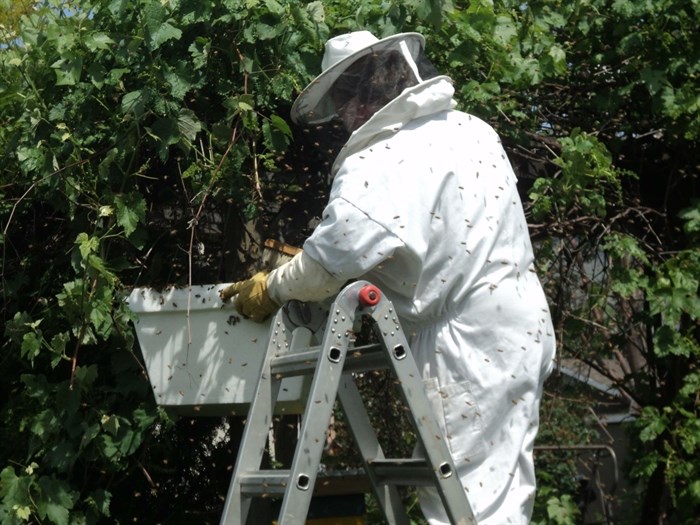
Kamloops beekeeper, Murray Willlis, handling a swarm of bees that landed in his back yard in 2016.
Image Credit: SUBMITTED/Murray Willis
May 27, 2019 - 8:00 PM
KAMLOOPS — A swarm of bees may look scary, but if they are honey bees, they aren't normally dangerous.
The best thing to do is call a local beekeeper who can take care of swarms — they'll probably thank you for it.
Murray Willis is a beekeeper who, over several weeks in May and June, responds to about eight to 15 calls to remove bee swarms in Kamloops — and he isn't the only one who does it.
The Kamloops Beekeepers have a directory of members who remove swarms in Kamloops and the surrounding area, including Ashcroft, Barrier, and Chase. There are also "swarm catchers" listed in the North Okanagan Beekeepers' webpage that cover the Okanagan.
"You don't get paid for it," Willis explains, "but we see it as free bees."
Swarming is how bees grow their colonies after becoming too populous for their original hive, according to the Kamloops Beekeepers webpage. They pack themselves around their queen, making a giant ball-like formation, and land anywhere that's convenient while "scout bees" go and find a more permanent settlement. They may land in one spot for a few minutes, or a few days, until they find a suitable new home.
You should never use pesticides on swarms of bees. Even on a regular day, when bees aren't swarming, stinging is a last-resort because after a honey bee stings it dies.
You can identify bees by their four wings, long "elbowed" antenna, and their pollen-collecting hairs, according to a City of Kamloops bee identification guide.
HOW TO HELP BEES
A starter kit or a "nuc" can cost about $225, Willis says. That includes the bees with a queen and a small wood hive. Beekeepers can also sell nuc colonies for profit.
However, Willis cautions anyone who might consider beekeeping that it is a lot of work, and can cost about $500 to get started.
Each city has its own set of rules for keeping bees. There are also provincial regulations to follow, and your hive needs to be checked annually by an apiary inspector.
The City of Kamloops also has restrictions on what properties can have beehives. You need to be situated on a lot equal to or greater than 370 m² zoned for either agriculture, future development, country residential, or suburban residential. There are a number of other guidelines listed in the city's bylaw when it comes to how many hives you can have.
Beekeeping in Vernon was legalized in April. Households can keep between two to four hives depending on the size of the property. In Kelowna you need a lot bigger than an acre and a half. In the South Okanagan you can have up to two bee hives in low density residential zones.
"The best thing people can do if you just want to save the bees is plant flowers," Willis says, adding that beekeepers can offer guidance to anyone who is still interested.
The City of Kamloops also has a guide on how to garden for pollinators, including bees, butterflies, and beatles.
To contact a reporter for this story, email Shelby Thevenot or call (250) 819-6089 or email the editor You can also submit photos, videos or news tips to the newsroom and be entered to win a monthly prize draw.
We welcome your comments and opinions on our stories but play nice. We won’t censor or delete comments unless they contain off-topic statements or links, unnecessary vulgarity, false facts, spam or obviously fake profiles. If you have any concerns about what you see in comments, email the editor in the link above.
News from © iNFOnews, 2019